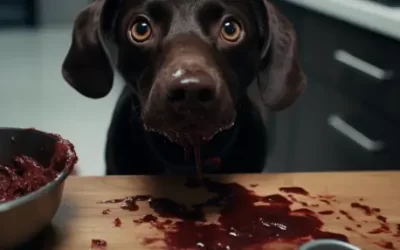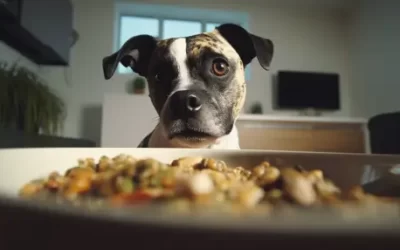As a devoted pet owner, the concern over what our dogs can and cannot eat is a familiar sentiment. The query “Can Dogs Eat Sun-Dried Tomatoes?” reflects a conscientious effort to ensure the well-being of our canine companions. It’s a journey I understand intimately, and it resonates with the desire to provide the best for our furry family members.
In my years as a seasoned veterinary professional immersed in the nuances of pet nutrition and health, I’ve encountered a myriad of inquiries surrounding canine dietary choices.
The question of whether dogs can consume sun-dried tomatoes is a common one, and I’m here to offer insights garnered through years of hands-on experience in the field of veterinary medicine.
My expertise encompasses a holistic understanding of canine nutrition, ensuring that the guidance provided is not only accurate but also grounded in a genuine concern for the well-being of your beloved pets.
If you’re seeking a definitive solution to the sun-dried tomato conundrum, you’ve landed in the right place. This article is crafted to unravel the complexities surrounding the safety, nutritional profile, and considerations involved in feeding sun-dried tomatoes to dogs.
Dogs should not eat sun-dried tomatoes. While tomatoes themselves aren’t toxic to dogs, the dehydration process concentrates the tomatoes’ compounds, including solanine, which can be harmful to dogs. Sun-dried tomatoes also often contain additional ingredients like garlic or onions, which are toxic to dogs.
Understanding Canine Nutrition

As a seasoned veterinary doctor, I approach the subject of canine nutrition with a deep understanding of the pivotal role it plays in a dog’s overall well-being. Proper nutrition is not merely a matter of sustenance; it’s the cornerstone of preventive healthcare for our furry companions.
Let’s delve into the intricacies of understanding canine nutrition, exploring the fundamental requirements, the significance of a balanced diet, and the specific nutrients essential for optimal canine health.
Dog’s Nutritional Requirements
Dogs, like humans, require a well-balanced and nutrient-rich diet to thrive. Their nutritional needs are influenced by factors such as age, size, breed, and activity level.
The primary macronutrients—proteins, fats, and carbohydrates—serve as the building blocks for energy, growth, and overall physiological functions.
Micronutrients, including vitamins and minerals, are equally vital in supporting various bodily processes. Striking the right balance ensures not only the dog’s growth and vitality but also fortifies their immune system and safeguards against potential health issues.
Importance of a Balanced Diet for Dogs
Maintaining a balanced diet is paramount for ensuring the longevity and vitality of our canine companions.
A well-balanced diet provides the necessary nutrients in appropriate proportions, preventing nutritional deficiencies or excesses. Dogs, being omnivores, benefit from a mix of animal proteins, healthy fats, carbohydrates, vitamins, and minerals.
The interplay of these elements supports muscle development, bone health, and cognitive function. Furthermore, a balanced diet contributes to a glossy coat, healthy skin, and optimal weight management.
Nutrients Essential for Canine Health
In the intricate tapestry of canine nutrition, certain nutrients stand out for their indispensable role in maintaining optimal health. Proteins, sourced from high-quality animal and plant-based ingredients, are crucial for muscle development, immune function, and enzyme production.
Essential fatty acids, such as omega-3 and omega-6, contribute to coat health, and skin integrity, and support cognitive function. Key vitamins like A, D, E, and B-complex, along with minerals like calcium and phosphorus, play pivotal roles in various physiological processes.
Recognizing the importance of these nutrients and ensuring their inclusion in a dog’s diet is a key aspect of responsible pet ownership and preventive healthcare.
Also Read: Can Dogs Eat Dried Pasta?
Sun-Dried Tomatoes: Nutritional Profile

Before exploring whether dogs can safely consume sun-dried tomatoes, it’s crucial to understand the nutritional makeup of this flavorful ingredient.
As a veterinary professional deeply invested in pet nutrition, I navigate the complexities of sun-dried tomatoes’ nutritional profile, shedding light on the potential benefits and considerations for our canine companions.
Breakdown of the Nutritional Content of Sun-Dried Tomatoes
Sun-dried tomatoes, a concentrated and dehydrated form of this vibrant fruit, boast a rich nutritional profile. They are a potent source of vitamins, including A, C, and K, providing antioxidants that combat oxidative stress.
Additionally, sun-dried tomatoes pack a punch with minerals like potassium, which is essential for maintaining proper electrolyte balance. However, a nuanced perspective is vital.
While these attributes may be beneficial to humans, it’s imperative to assess how this nutritional content aligns with the unique dietary needs of dogs. Understanding the intricacies of sun-dried tomatoes’ composition allows us to make informed decisions regarding their inclusion in a canine diet.
Potential Benefits of Certain Nutrients for Dogs
Certain nutrients found in sun-dried tomatoes can offer potential benefits for dogs when incorporated judiciously. The antioxidant properties of vitamins A and C contribute to immune system support, aiding in the defense against infections and diseases.
Potassium, a key electrolyte, plays a role in maintaining proper heart function and muscle contractions. However, as with any food intended for dogs, moderation is key.
While there are potential advantages, an excess of certain nutrients may lead to unintended health consequences.
Consideration of Potential Drawbacks or Harmful Components
While sun-dried tomatoes offer nutritional benefits, caution is warranted due to potential drawbacks and harmful components. These tomatoes are often preserved with additives like salt or herbs, which may not align with a dog’s dietary requirements.
Additionally, the concentrated nature of sun-dried tomatoes means a higher concentration of natural sugars, which can be problematic for dogs, especially those with diabetes or weight concerns.
Furthermore, the presence of certain compounds like solanine in tomatoes, albeit in small amounts, necessitates careful consideration, as excessive consumption can lead to gastrointestinal upset.
Also Read: Can Dogs Eat Freeze Dried Mango?
The Safety Aspect

Ensuring the safety of our canine companions is paramount when considering incorporating unconventional foods into their diets. As a veterinary professional deeply committed to canine health, I meticulously examine the safety aspect of feeding sun-dried tomatoes to dogs.
In this exploration, we delve into potential risks, toxic components, and the consideration of allergic reactions or sensitivities.
Potential Risks Associated with Feeding Sun-Dried Tomatoes to Dogs
While sun-dried tomatoes may seem like a wholesome addition, it’s essential to acknowledge potential risks that can arise when introducing this ingredient into a dog’s diet. One prominent concern is the high salt content often used in the preservation of sun-dried tomatoes.
Excessive salt intake can lead to electrolyte imbalances, dehydration, and increased blood pressure in dogs. Moreover, the concentrated nature of these tomatoes may contribute to digestive issues, including upset stomach or diarrhea.
In addressing these potential risks, it becomes evident that careful consideration and moderation are crucial when contemplating sun-dried tomatoes as part of a canine diet.
Toxic Components that May be Harmful to Dogs
A nuanced understanding of the potentially toxic components in sun-dried tomatoes is essential for responsible pet ownership. While tomatoes themselves are generally considered safe for dogs, certain elements, such as solanine, can be present in small amounts and pose risks.
Solanine is a naturally occurring compound found in tomatoes, and although the levels are typically low, excessive consumption can lead to gastrointestinal distress, lethargy, or, in severe cases, more serious health issues.
Recognizing the fine line between the benefits and potential harm is imperative, emphasizing the need for prudence when introducing sun-dried tomatoes into a dog’s diet.
Any Potential Allergic Reactions or Sensitivities to Consider
Dogs, like humans, can exhibit allergic reactions or sensitivities to certain foods, and sun-dried tomatoes are no exception. The concentrated nature of these tomatoes may intensify the likelihood of adverse reactions. Allergies could manifest as itching, gastrointestinal upset, or respiratory distress.
Additionally, some dogs may have specific sensitivities to the additives or preservatives commonly used in sun-dried tomatoes. As a veterinary professional, I stress the importance of observing for any signs of allergic reactions and consulting with a veterinarian if concerns arise.
This proactive approach ensures the well-being of our furry friends while allowing for a nuanced understanding of potential sensitivities.
Also Read: Can Dogs Eat Dried Squid?
Moderation and Portion Control

Navigating the intersection of canine health and dietary choices involves a delicate balance, particularly when considering the inclusion of human foods.
As a seasoned veterinary professional, I advocate for an approach grounded in moderation and meticulous portion control.
In this segment, we delve into the significance of moderation when treating dogs with human food, offer guidelines on appropriate portion sizes, and shed light on potential issues linked to excessive consumption.
Moderation in Treating Dogs with Human Food
The allure of sharing our meals with our canine companions is undeniable, yet it’s crucial to approach this practice with a mindful perspective.
Emphasizing the importance of moderation is paramount. While some human foods may offer nutritional benefits, exceeding appropriate quantities can lead to a host of health issues for dogs.
As a veterinary professional, I encourage pet owners to view such treats as occasional indulgences rather than regular components of a canine diet. This measured approach ensures that the joy of sharing food with our furry friends aligns with their health and well-being.
Guidelines on Appropriate Portion Sizes for Dogs
Determining suitable portion sizes for dogs requires an understanding of their characteristics, including size, breed, age, and activity level. When considering sun-dried tomatoes or any human food, moderation extends to portion control.
A general guideline is to offer treats that constitute no more than 10% of a dog’s daily caloric intake. For smaller breeds, this may translate to a few small pieces, while larger breeds may accommodate slightly more.
It’s crucial to account for the additional calories provided by treats to maintain a balanced overall diet. By adhering to these portion control guidelines, pet owners can strike a harmonious balance between canine indulgence and nutritional prudence.
Potential Issues Related to Excessive Consumption
Excessive consumption of human foods, even those deemed safe for dogs, can lead to a spectrum of health issues. When it comes to sun-dried tomatoes, the concentrated nature introduces the risk of overconsumption of certain nutrients.
The potential for gastrointestinal upset, including vomiting or diarrhea, increases with excessive intake. Furthermore, the caloric load from treats can contribute to weight gain and obesity, posing long-term health risks.
By highlighting these potential issues, I aim to empower pet owners to exercise caution and mindfulness in their approach to treating dogs with human foods. Awareness of the consequences of excessive consumption fosters a responsible and proactive stance toward canine nutrition.
Also Read: Can Dogs Eat Dried Pasta?
Preparing Sun-Dried Tomatoes for Dogs

As we explore the intersection of canine culinary delights and responsible pet ownership, how we prepare and present foods to our dogs takes center stage.
In this segment, as a veterinary professional with a keen understanding of pet nutrition, I shed light on safe methods of preparing sun-dried tomatoes for dogs.
Additionally, we delve into the importance of avoiding additives or seasonings that could be harmful and consider alternative variations for dogs with specific dietary needs.
Safe Methods of Preparation for Dogs
Ensuring the safety of sun-dried tomatoes for canine consumption begins with the preparation process. Opting for homemade, unsalted, and additive-free sun-dried tomatoes is the safest route. Start by selecting fresh, high-quality tomatoes and dehydrating them without the use of excessive salt or potentially harmful seasonings.
This homemade approach not only allows for a controlled and safe process but also eliminates the risk associated with commercially prepared sun-dried tomatoes.
By employing safe preparation methods, pet owners can introduce this treat into their dog’s diet with confidence, knowing that the culinary indulgence aligns with their pet’s well-being.
Avoiding Additives or Seasonings that Could be Harmful
Commercially available sun-dried tomatoes often come adorned with seasonings, herbs, or salt that may not be conducive to a dog’s health.
When preparing sun-dried tomatoes for canine consumption, it is paramount to steer clear of additives and seasonings that could be harmful. Dogs, with their unique sensitivities, may react adversely to certain flavorings or preservatives.
I advise pet owners to prioritize simplicity in preparation, focusing on the natural sweetness and richness of the tomatoes. This cautious approach ensures that the treat remains a wholesome addition to a dog’s diet without introducing potentially harmful elements.
Alternatives or Variations for Dogs with Specific Dietary Needs
Recognizing the diversity of dietary needs among dogs, it’s essential to consider alternatives or variations when preparing sun-dried tomatoes. For dogs with specific dietary requirements or sensitivities, alternative methods of preparation can be explored.
This may involve adjusting the dehydration time, incorporating different tomato varieties, or even exploring alternative fruits and vegetables that align with a dog’s individual needs.
Tailoring the preparation process to accommodate specific dietary considerations ensures that the treat remains inclusive, allowing all dogs, regardless of their unique health requirements, to partake in the joy of sun-dried tomatoes safely and enjoyably.
Also Read: Can Dogs Eat Freeze Dried Mango?
Signs of Allergies or Digestive Issues

While the prospect of treating our dogs to culinary delights is undeniably tempting, responsible pet ownership entails a keen awareness of potential signs of allergies or digestive issues.
As a veterinary professional, I guide pet owners through recognizing these indicators when introducing sun-dried tomatoes into their dog’s diet.
This segment aims to educate readers on common signs, emphasize the importance of vigilant monitoring, and stress the individual variations in canine tolerance that demand personalized attention.
Signs of Allergies or Digestive Problems in Dogs
Understanding the nuanced language of a dog’s body is essential in safeguarding their well-being. Common signs of allergies or digestive problems include persistent itching, redness, gastrointestinal upset, vomiting, or diarrhea.
These manifestations can be indicative of adverse reactions to certain foods, including sun-dried tomatoes.
Monitoring and Seeking Veterinary Advice if Issues Arise
Vigilant monitoring of a dog’s behavior and physical well-being following the introduction of sun-dried tomatoes is crucial. I encourage pet owners to observe their canine companions for any deviations from their usual behavior or signs of discomfort.
Should any issues arise, seeking prompt veterinary advice is imperative. Timely consultation with a professional allows for a comprehensive assessment of the situation and ensures that any potential health concerns are addressed promptly. This proactive approach underscores the commitment to the health and happiness of our furry friends.
Importance of Individual Variations in Canine Tolerance
Each dog is a unique individual with their own set of preferences and tolerances. Stressing the importance of recognizing individual variations in canine tolerance is paramount. What suits one dog may not be suitable for another.
Also Read: Can Dogs Eat Dried Squid?
Final Thoughts: Can Dogs Eat Sun-Dried Tomatoes

Dogs can eat sun-dried tomatoes in moderation. While these tomatoes offer some nutritional benefits, including vitamins and minerals, it’s crucial to be cautious.
Store-bought varieties often contain additives like salt or seasonings that can be harmful to dogs, so it’s safer to prepare homemade, unsalted sun-dried tomatoes. Additionally, the concentrated nature of these tomatoes means that excessive consumption may lead to digestive issues.
Always introduce new treats gradually and monitor your dog for any signs of allergies or sensitivities. If in doubt, consult with your veterinarian for personalized advice based on your dog’s individual health and dietary needs.
Key Points Discussed in the Article
Throughout this journey, we’ve delved into the intricate tapestry of canine nutrition, deciphering the nuances of sun-dried tomatoes’ nutritional profile and safety considerations. We’ve emphasized the need for moderation, careful preparation, and an acute awareness of potential risks.
The significance of recognizing signs of allergies or digestive issues has been underscored, providing readers with a comprehensive guide to making informed decisions about treating their dogs.
Reiterating the Importance of Responsible Pet Feeding
In the world of pet ownership, the choices we make regarding our dogs’ diets carry profound implications for their health and well-being. The recurring theme throughout this article has been the importance of responsible pet feeding.
Treating our dogs with human foods like sun-dried tomatoes should be approached with a balanced blend of delight and caution.
By embracing moderation, portion control, and mindful consideration of potential risks, pet owners can elevate their canine companions’ culinary experiences while safeguarding their long-term health.
Encouraging Readers to Consult with Veterinarians for Personalized Advice
While this exploration provides a robust foundation of knowledge, the uniqueness of each dog demands personalized attention. As a veterinary professional, I extend a heartfelt encouragement for readers to consult with veterinarians for advice tailored to their pets.
Veterinary experts possess the expertise to offer guidance aligned with specific breeds, health conditions, and dietary needs. Seeking professional advice ensures that the choices made for our dogs’ diets are not only enjoyable but also in harmony with their overall health objectives.









